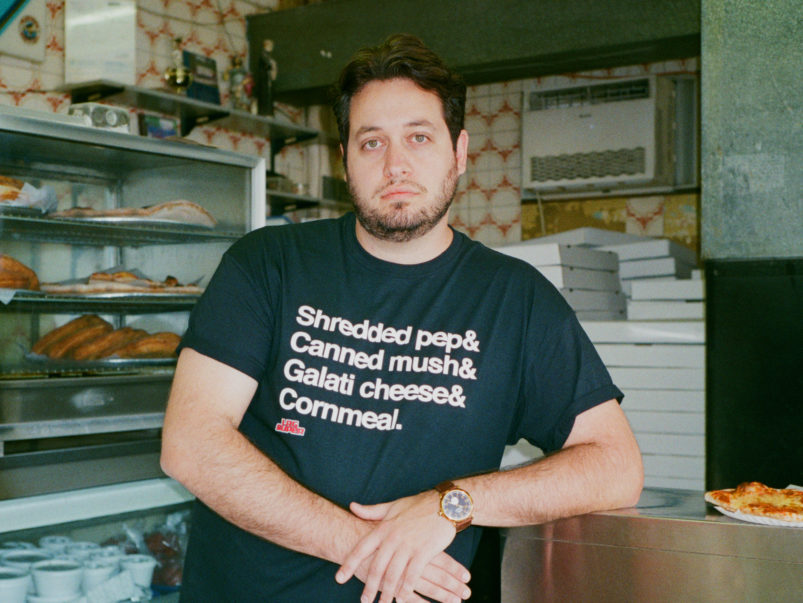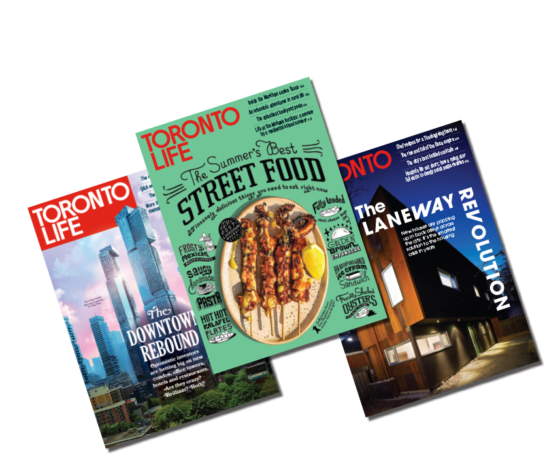“Toronto is most characterized by the diversity of our pizzas”: A Q&A with the York University historian who ate 712 slices of pizza for his PhD thesis
Alex Hughes talks big chains versus mom-and-pops and why pineapple is the ultimate Toronto topping

In 1956, Vesuvio’s, Toronto’s very first pizzeria, was opened by a family of Italian immigrants in the Junction. From that moment on, the city has produced an endless array of slices and pies from humble to haute. Is there a quintessential Toronto-style slice? “At this point, Toronto is probably most characterized by the diversity of our pizzas—you can even get General Tso pizza,” says Alex Hughes, a historian at York University who recently wrote his PhD thesis on the commodification of pizza in Toronto and Buffalo after the post-war boom. Ten thousand articles and more than 712 slices later, Hughes believes pizza is an important cultural barometer. Here, he talks big chains versus mom and pops and why pineapple is the ultimate Toronto topping.
What kind of educational background led you to your delicious field of study?
My background is in history—I graduated from Wilfred Laurier University in 2014 with a BA in history and got my master’s the following year. My area of focus is the cultural history of Canada and, to a lesser extent, the United States. Food history falls under that umbrella—for me, it’s a lens through which to explore other histories. So, with my thesis, yes, it’s about the culture and commodification of pizza in Toronto and Buffalo, but really it’s an exploration of immigration, economics, business, labour and gender. I came up with the idea after watching a documentary about the different regional styles of pizza in Italy. It made me think about how the same was true in our part of the world, where various styles are associated with different cities.
Why did you decide to compare Toronto with Buffalo?
Even before I landed on pizza as my lens, I had been looking into the relationship between these two cities: they’re both on Lake Ontario and connected by the Golden Horseshoe. Before this project, I didn’t know much about Buffalo beyond chicken wings and The Goo Goo Dolls. What I found really interesting was that Toronto and Buffalo were very similar at the start of the post-war era when it came to their population size and economic output. But then they went on completely different paths over a 40-year period, with Toronto becoming this economic centre and multicultural metropolis while Buffalo became a smaller regional city that suffered from de-industrialization and population loss.
And this resulted in different styles of pizza?
Not just different styles but also different methods of commodification. In both cities, pizzerias emerged out of the so-called ethnic economies, where marginalized communities developed specialties in niche industries. Buffalo’s first pizzeria, Santora’s, started as a family business in 1927. The Santora family sold pizza from their home as a way of feeding neighbours and making money. In Toronto, non-Italians first experienced pizza through at-home recipes—things like the Chef Boy-Ar-Dee kit. Canadians wanted something better, so they turned to the Italian community. Vesuvio’s, Toronto’s first pizzeria, was opened in 1956 by a family of Italian Canadians. By the 1960s, there were similar spots opening in the suburbs, still coming from the Italian Canadian community. Then, in the 1970s, the big chains arrived—some, like Pizza Nova, were founded by Italian Canadians while others, like Pizza Pizza, were not. American chains—Domino’s, Little Caesars, Pizza Hut—started to open here in the ’70s and ’80s, and we ended up with a culture of what I call “standardized pizza,” where you have this very consistent product produced by major corporations. Buffalo’s pizza industry, on the other hand, remained smaller, focused on independent mom-and-pop-style pizzerias that were also selling sub sandwiches or wings, and really reflected that blue-collar culture.
How did Toronto go from a chain city to a city of pizza snobs?
In the mid-’80s and early ’90s, you had the peak of big chain pizza when McDonald’s started selling it.
Unpopular opinion: the McPizza was actually really good.
I don’t think the problem was with the taste so much as how much time it took to produce: about nine minutes. Everything else at McDonald’s was ready a lot faster, which is what customers expected. But, overall, this era of chain dominance led to a backlash where people wanted authenticity.
Revenge of the nonnas!
Exactly. There was this new emphasis on quality ingredients, Italian ingredients. There were “mama slices” and “nonna slices”—nothing fancy, just the real deal. From there, we entered the era of gourmet pizzas or California pizza, so thin-crust pizzas made in wood-fired ovens and topped with ingredients that had not previously been considered pizza toppings—things like artichokes and goat cheese. This was very much the influence of celebrity culture, which had become a lot more accessible with the explosion of gossip magazines. Suddenly, people in Toronto were looking at pictures of a celebrity eating a smoked salmon pizza at Spago.
Is there such a thing as Toronto-style pizza?
In some ways, the standardized style would be a thicker crust and a chunkier sauce, which has to do with importation laws that prevented us from getting San Marzano tomatoes, so Italian immigrants did what they could with local produce. That was in the 1990s, though. At this point, Toronto is probably most characterized by the diversity of our pizzas. You can even get General Tso pizza.
I’m guessing your research involved a lot of pizza consumption.
I did eat a lot of pizza—712 slices over four years. I don’t know how necessary that was to my research; you can’t taste what pizza used to taste like in the past, which is my focus as a historian. But it was fun to immerse myself in any way possible: I went to the World Pizza Expo in Vegas in 2019, and I was a judge at the Canadian Pizza Summit that same year, but the majority of my time was spent alone in the Toronto Reference Library, reading every Globe and Mail or Toronto Star article with the word “pizza” in it from 1950 to 1990—about 10,000 articles.
Was there a most interesting factoid that came out of your research?
There was this period in the early ’90s where there seemed to be a wave of pizza-related crimes, or they were at least getting a lot of media attention. There was this one group of kids from the Flemingdon Park neighbourhood who would order pizzas to different locations and then, when the driver got out to deliver the first order, they would steal the rest of the pizza from the car. I was surprised by the amount of coverage it got.
Pizza theft feels pretty quaint compared to today’s headlines.
It really does.
Why did you end your research in 1990? Pizza has made a lot more history since then.
It’s a question of when history ends and the present begins—and 40 years of study from post-war to the ’90s felt like a good chunk of time. I’m planning to write a book where I hope to extend my research into the modern era and get at the idea of so-called pizza snobs and the rise of celebrity chefs.
Related: How the pandemic—and $13 million—is turning General Assembly into a frozen-pizza powerhouse
Was there a pie or a slice that stood out against all others?
I love Hawaiian pizza, both because it tastes delicious and because it is the quintessentially Canadian pizza. Despite its name, Hawaiian pizza was invented at Satellite Restaurant in Chatham, Ontario. It was owned by a Greek Canadian who made both diner-style food and Chinese food all in one kitchen. One day, he was making sweet-and-sour chicken, so he threw some pineapple chunks on a pizza—and it tasted delicious.
That’s debatable. Why is pineapple on pizza so controversial?
I think there are a lot of people who just can’t get past the idea of fruit on pizza.
What about a least-favourite pizza experience?
In Buffalo they make Hawaiian pizza with maraschino cherries in the centre of the pineapple ring, or at least they did that at one location. It was almost too sweet.
Thoughts on the recent pickle pizza trend?
I have tried it, and it’s not my favourite. At the Canada Pizza Summit, I tried a pizza that was topped with those spicy pickled green beans—the kind you put in a caesar. I wasn’t a fan.
Have you seen Pizza Pizza’s new dipping sauce roller?
I have. My wife is one of those people who thinks dipping sauce should cover an entire slice, so I’m trying to get my hands on one. I actually sent them a DM, but I haven’t heard back. This is the latest in a long line of gimmicks. That’s how we got stuffed-crust pizza and, more recently, pretzel-crust pizza.
I think a whole bunch of nonnas just rolled over in their graves.
But that’s the thing about pizza in Toronto—there’s room for a lot of different styles and price points.
How much is too much to pay for pizza?
I’ve heard of an $800 pizza in Richmond, BC, topped with caviar, lobster, smoked salmon and truffles. The most I ever spent on a pizza was $60 for a deep dish in Chicago, and I spent $30 on a mega slice from Lamanna Bakery. I was a student for the majority of my research, though, so I tended to stick to cheaper options.
What’s your go-to pizzeria?
I don’t want to say—because I don’t want to single out one spot, but also because I want to keep my favourite place under the radar.









